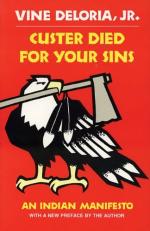
|
| Name: _________________________ | Period: ___________________ |
This test consists of 5 multiple choice questions, 5 short answer questions, and 10 short essay questions.
Multiple Choice Questions
1. What kind of people do anthropologists believe the Indians are?
(a) A folk people.
(b) A native people.
(c) A foreign people.
(d) A white people.
2. How long did the Indians have under the Wheeler-Howard Act to make a decision about their reservation?
(a) 10 years.
(b) 1 year.
(c) 9 months.
(d) 2 years.
3. Why did the Oglala Sioux become a favorite subject for study by anthropologists?
(a) Because of the vibrant present.
(b) Because of their unique way of life.
(c) Because of their romantic past.
(d) Because of the art history.
4. Who saved the Florida Seminoles from termination?
(a) Arthur Watkins.
(b) The D.A.R. or Daughters of the American Revolution.
(c) The governor of Florida.
(d) Congress.
5. What has created a feeling of unity among American Indians?
(a) Need for social services.
(b) The Native American College system.
(c) Brotherhood with a similar history.
(d) The betrayal of treaty promises.
Short Answer Questions
1. How did the government get the Klamaths to agree to termination?
2. What does the author believe anthropologists should do in the future?
3. Who was asked to testify before the Senate Civil Service Committee in 1947?
4. What was the Senate Interior Committee afraid of after the passage of the Wheeler-Howard act?
5. What "first" did the Treaty of August 5, 1826 enact?
Short Essay Questions
1. How have the workshops offered by anthropologists affected the young Indians?
2. How did William Zimmerman, Acting Commissioner of Indian Affairs classify existing tribes into categories for Termination?
3. What was Frank Church's attitude towards the Indian? Why was this line of thought so harmful during the time of Termination?
4. Why has the Indian Reorganization Act responded so well to fit the European white model?
5. What did the Treaty of August 5, 1826 with the Chippewa tribe do?
6. What are the Five Civilized Tribes and why are they referred to in this way?
7. What is the history of the Sioux who lived along the Missouri River?
8. How did Indians become citizens and what effect did this have on Termination?
9. What was the term "dependency," as used in the Delaware Treaty of September 17, 1778?
10. Why are the American Indians lost when, in Congressional hearings, the chairman of the committee talks about the Anglo-Saxon heritage of law and order?
|
This section contains 1,182 words (approx. 4 pages at 300 words per page) |

|




